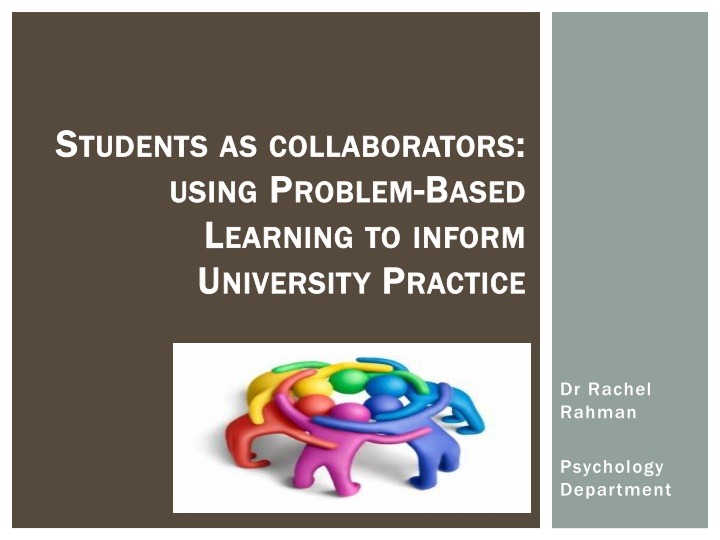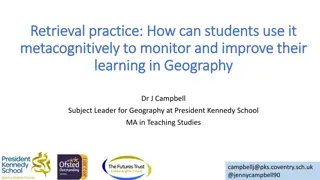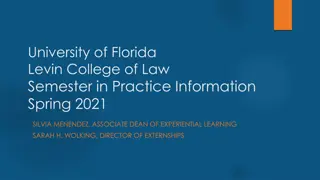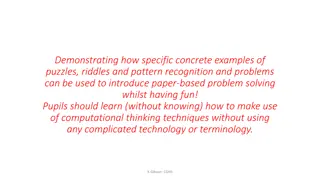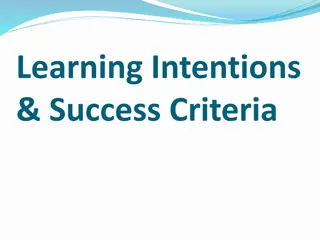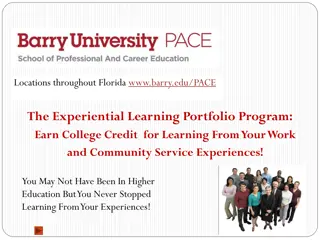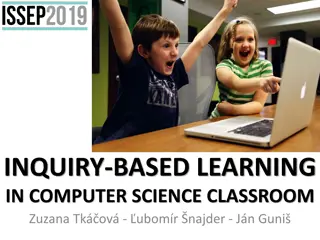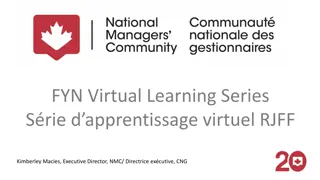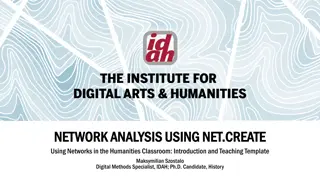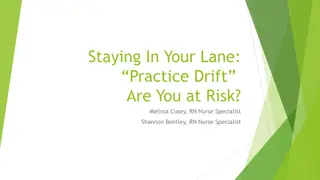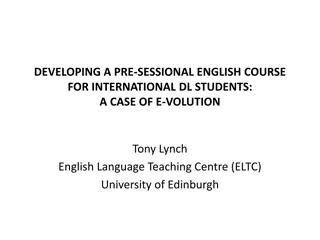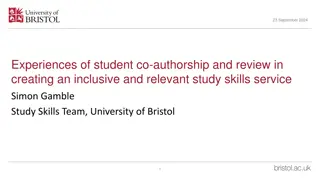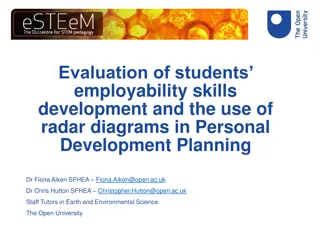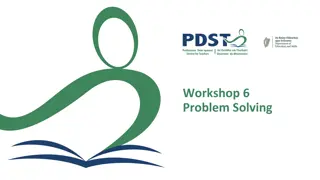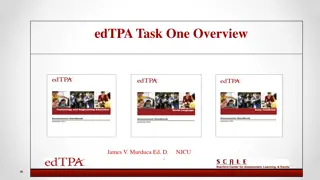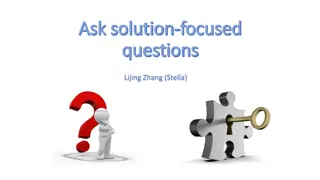Collaborating Students Using Problem-Based Learning in University Practice
Dr. Rachel Rahman from the Psychology Department presents a unique approach to engage students as collaborators in university practice. By implementing problem-based learning strategies, this initiative aims to enhance student-student interactions and foster a dynamic learning environment. Through this innovative method, students are encouraged to actively participate, think critically, and develop practical skills that extend beyond traditional classroom settings. This collaborative approach not only enriches the educational experience but also cultivates a sense of ownership and responsibility in students towards their own learning journey.
Download Presentation

Please find below an Image/Link to download the presentation.
The content on the website is provided AS IS for your information and personal use only. It may not be sold, licensed, or shared on other websites without obtaining consent from the author.If you encounter any issues during the download, it is possible that the publisher has removed the file from their server.
You are allowed to download the files provided on this website for personal or commercial use, subject to the condition that they are used lawfully. All files are the property of their respective owners.
The content on the website is provided AS IS for your information and personal use only. It may not be sold, licensed, or shared on other websites without obtaining consent from the author.
E N D
Presentation Transcript
S STUDENTS TUDENTS AS AS COLLABORATORS COLLABORATORS: : USING USING P PROBLEM ROBLEM- -B BASED L LEARNING EARNING TO U UNIVERSITY NIVERSITY P PRACTICE ASED INFORM RACTICE TO INFORM Dr Rachel Rahman Psychology Department
OVERVIEW OF PRESENTATION Set the scene of the module Background pedagogical approach Overview of the practical approach Evaluation Reflection
OVERVIEW OF THE MODULE PS31220 Health psychology PS31220 Health psychology is a third year option module Typically 50-70 students registered each year Topics: Topics: Determinants of health risk behaviour Health perception Measuring health Behaviour change Intervention design Health communication and promotion Coping and chronic disease Assessments include Assessments include: Health promotion poster and outline (40%) Exam (60%)
WHAT I WANTED TO ACHIEVE Learning Learning Engage students with research literature Become more adept at applying psychological theory Critical thinking Employability Employability Better understand the complexities of health psychology Have an opportunity to include an interesting approach to health psychology on their CVs As an academic As an academic Opportunity to better integrate my teaching with University policy and practice
BACKGROUND The pedagogical approach Problem based learning (Project pathway) Co-operative inquiry "Tell me and I forget, show me and I remember, involve me and I understand."
PROBLEM BASED LEARNING PBL PBL involves developing knowledge by setting problems or challenges that require students to research the area in order to solve the problem (Barron & Darling-Hammond, 2008). Project pathway Project pathway involves working on a set project or task with an objective to develop a product as an outcome Evidence that students using PBL and project pathways show better: Critical thinking and reasoning Transferability of information to novel situations Confidence in their learning Project planning (Penuel, Means, & Simkins, 2000) Savery (2015)
CO-OPERATIVE INQUIRY A way of working with other people who have similar concerns and interests in order to: Understand your world, Develop new and creative ways of looking at things. Learn how to act to change things you may want to change and find out how to do things better (Heron & Reason, 2000) In co-operative inquiry all those involved in the endeavour are co-researchers, and co-subjects, (Reason, 2002) Evidence that students using Co-operative inquiry show better Problem solving Transferability of information to novel situations Team working skills (Barron & Darling-Hammond, 2008)
HOW IT WORKED Co-operative inquiry between University's Student Support Services and health psychology students Student support identified 3 problem based case studies
SEMINARS Worked in self-selected groups of 4-8 on a chosen case 4 seminars 4 seminars designed around concept of intervention mapping Introduced to an ecological model and asked to consider determinants of their chosen behaviour Researched promotional material and health communication on campus, websites, GPs Considered an appropriate behaviour change theory to underpin an intervention Completion of the intervention and development of a pitch Research and reading expected in-between sessions to support ideas and suggestions
HOW IT WORKED IN ASSESSMENT Final lecture of the module each group pitched their idea in 8 minutes to a member of student support staff Presentation not assessed but opportunity for formative feedback From this point students were required to work individually to prepare for an exam question on this topic area. Exam: Section A: Choice of 3 essay questions-answer 1 Section B: Question based on the portfolio development
EXAM QUESTION Using an example of your choice, outline a health intervention suitable for targeting a student population. Your answer should consider theoretical underpinnings, and research evidence to justify the approach and specifically address: the behaviour in question the determinants of the behaviour to be addressed the intervention approach with justification
EXAM PERFORMANCE 100 Average exam mark Average exam mark 90 80 70 58 60 54 50 % % 40 30 20 10 0 2013-14 2014-15
EVALUATION OF THE APPROACH Caryl Davies Student Support The initiative to involve Student Support Services in a third year Health Psychology module has provided a novel and valuable opportunity to involve students in the way that the university deliver health promotion interventions and to enable us to focus health promotion activities in a format students are more likely to engage with... we are now seeking further ways to collaborate for example, to engage psychology students in evaluating our wellbeing service Angharad Jones, Student Nurse I thought it was really valuable to have students perspective and proposals on real problems that we (as an university) are facing. It was good for students to see that we work together as well. The balloon challenge about smoking is a great idea, and something I want to pursue at some point. My suggestion for the future would be, that as some of the projects involved the SU taking the lead, it would be good to invite the SU Welfare Officer for this year.
QUANTITATIVE FEEDBACK The portfolio helped me to 5 4 3 2 1 0
QUALITATIVE FEEDBACK I found the process very helpful in coming up with an intervention. I noticed we all had the tendency to rush to an intervention before thinking of other stages in the process and so the seminars and actual piece of work was helpful for guidance and of course helpful not only in the exam, but in understanding fundamental processes in health psychology. On-going feedback during the sessions was invaluable to ensure that the group were on the right track...Doing the pitch to Student Support was particularly valuable as it meant that we could see how realistic our suggestions would be. I enjoyed working as a group to produce the work, preferred that to working on my own! I also liked that it helped us to know what was coming up in the exam
QUANTITATIVE FEEDBACK 5 4 3 2 1 0 Pitch generally was helpful Pitch helped to consolidate information and identify important elements Feedback form student support was helpful Feedback from other students was helpful Fedback from the convenor was helpful Listening to ideas of others was helpful Providing feedback to other goups was helpful
QUALITATIVE FEEDBACK The only (small) gripe is that, because the presentations were not marked, a small number of people did not attend them. However, I think that things should stay the same as it is up to the individual to take responsibility for their own learning in year 3 and I am sure that those who attended gained a lot which they could use in their exams. I found hearing feedback for others stressful because some got more positive feedback than others so those with more negative feedback had more work to sort it for the exam. Overall I liked it but would prefer it to be assessed differently within the exam (maybe worth less percent? Or combined with MCQs or short answer questions on a wider range of lecture material to make it more worthwhile revising
REFLECTIONS Collaborating with service departments was beneficial Developed onto future collaborations Collaboration provides understanding from all parties about perspectives to the problem. Students didn t engage with the literature as well as I had hoped Pitch needs careful management
Thank you Diolch QUESTIONS
REFERENCES Barron, B. & Darling-Hammond,L. (2008). Powerful learning: Studies show Deep understanding derives from collaborative methods.Accessed on September 5th via http://www.edutopia.org/inquiry-project-learning-research Heron,J. & Reason, P. (2001). The practice of co-operative inquiry: Research with rather than on people. P. Reason & H. Bradbury (Eds.), Handbook of Action Research: Participative Inquiry and Practice (pp. 179-188). London: Sage Penuel, W.R., Means, B., & Simkins, M. (2000) The Multimedia challenge. Educational Leadership, 58, 34-38. Reason, P. (2002). The Practice of Co-operative Inquiry. Systematic Practice and Action Research, 15, 169-176. Savery, J.R. (2015). Overview of problem based learning; definitions and distinctions. In P.A. Ertmer (Ed.) Essential readings in Problem Based Learning. Purdue University Press.
